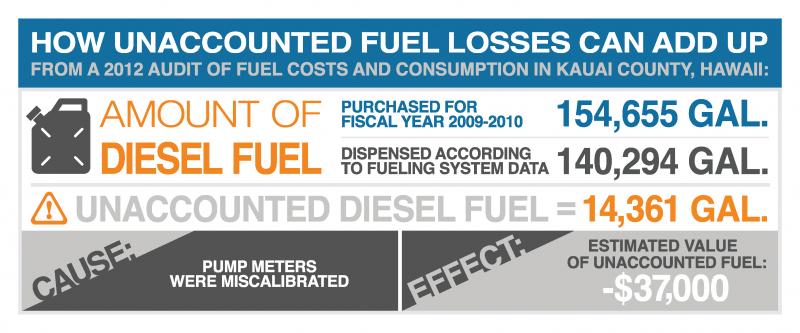Technology-driven fuel reconciliation: Modern solution to traditional fleet financial challenges
By Jeremy Lewis
 Fuel inventory reconciliation may seem like a minor part of fuel management, but it is one that could have major financial implications. Public sector fleets that still rely on manual reconciliation practices for tracking their fuel inventories and meeting compliance reporting requirements are putting operating budgets — and taxpayer dollars — at risk.
Fuel inventory reconciliation may seem like a minor part of fuel management, but it is one that could have major financial implications. Public sector fleets that still rely on manual reconciliation practices for tracking their fuel inventories and meeting compliance reporting requirements are putting operating budgets — and taxpayer dollars — at risk.
The High Cost of SIR
Most of today’s government fleets — regardless of size or type — require drivers to fuel up at a private fuel yard. The fuel at these terminals, which are almost always unattended, are especially vulnerable to theft, undetected system leaks, dispensing equipment problems and more. These problems are difficult to trace and can amount to hundreds of thousands of dollars in unaccounted fuel losses. Take for example, the discrepancies one Hawaii county discovered. In 2012, Kauai County audited its fuel usage and found the county had almost $37,000 worth of unaccounted fuel over the course of a year.

Most of today’s government fleets still practice an antiquated form of reconciliation known as statistical inventory reconciliation (SIR). However, SIR is labor intensive and error prone. To obtain accurate inventory data via SIR, personnel must be allocated to manually record inventory measurements — which includes every fuel product on site, the amount of water in each product’s tank, the amount of fuel dispensed and the amount of fuel deliveries — at the same time each day and every day the yard is in operation.
Once the data is gathered, the variance — the difference between the amount of fuel reported being delivered and being dispensed — needs to be calculated using complex formulas. Manual reconciliation calculations are typically executed longhand or with the assistance of a spreadsheet, two methods that are prone to user error.
Variance is not only a benchmark for the accuracy of inventory data collection, but it is a measure of the overall fitness of a fuel system. Many states require fuel sites to report their variance as part of their leak detection documentation. Failure to meet state-mandated variance thresholds typically results in compliance fines and expensive corrective actions, including third-party tank tests.
In addition, without access to electronically generated data, variance remediation efforts are sometimes misguided, resulting in unnecessary expenses. Lacking hard metrics, fuel managers speculate at the root causes for unacceptable variance levels and, frequently, rely on anecdotal knowledge to guide their corrective actions. Often their diagnosis of the problem — and the costly solution for it — is wrong. Additionally, unable to quickly “trend” SIR data, many public sector fleet yards have run out of fuel simply because they were unable to project when a tank would run dry. A tank void of fuel contains sludge on the bottom of the tank, which can cause pump equipment failures and damage to vehicles.
Software-Based Solution
Although it may seem counter-intuitive, investment in fuel management equipment such as a tank gauge and software that performs reconciliation can actually save government fleets money over the long road. County and city fleet managers who replace manual reconciliation procedures with an automated, technology-driven reconciliation program will significantly increase control of their fuel inventory while minimizing their risk of financial implications caused by unaccounted fuel losses. By enabling resources that would otherwise be devoted to SIR tasks to be reallocated, management overhead also can be reduced. With these time and cost savings, fuel sites that invest in fuel management equipment solutions can expect a quick return on investment.
Fuel management is an essential part of government fleet management. Fleets that minimize fuel losses and streamline yard administration workflows through automated reconciliation equipment will not only reduce operating expenses in the short-term, they will be better prepared to weather unexpected expenses in the long-term.
Jeremy Lewis is the Commercial Business Development Manager – Fuel Control at OPW Fuel Management Systems in Hodgkins, Ill.




















